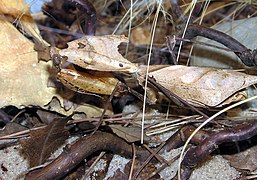Deroplatys desiccata
| Deroplatys desiccata | |
|---|---|
| Scientific classification | |
| Kingdom: | Animalia |
| Phylum: | Arthropoda |
| Class: | Insecta |
| Order: | Mantodea |
| Family: | Deroplatyidae |
| Genus: | Deroplatys |
| Species: | D. desiccata
|
| Binomial name | |
| Deroplatys desiccata Westwood, 1839
| |
| Synonyms | |
| |
Deroplatys desiccata, known by the common name giant dead leaf mantis, is a praying mantis from Southeast Asia. This is the type species of genus Deroplatys.
Description[]
D. desiccata takes its common name from its resemblance to dead, leafy vegetation including having a flattened, greatly extended thorax and "intricate leaf patterns" on its wings.[1][2] This insect varies in color from mottled brown through "pale orangey brown" to a very dark brown that is almost black.[3]
This creature's camouflage is aided by its movements as well as its appearance. When disturbed, it rocks gently as if caught in the breeze. When threatened, it typically falls to the ground and lies motionless.[3][4][5][6] It can also react with a threatening display consisting of "black underwings splayed out, with large eyespots, frightening away unsuspecting predators."[7] The intricate lines on the mantis' body, which serve to look like the natural veins on a leaf, as well as its dark brown colors, are beneficial to the species as it has been shown to avoid the attention of aerial predators or other insects.
As its common name indicates, D. desiccata is larger than other species of dead leaf mantis. Females grow to 75–80 mm long. Displaying the sexual dimorphism typical of mantises, males grow only 65–70 mm long and are substantially smaller and lighter than females.[3][4][8][9] Females' prothorax shields end in a sharp pointed curve on each side while the males have a rounder shape. According to one source, males tend to be more "yellowish" than the darker females.[10]

Adult female at Bristol Zoo, 2007

Male prepared in the Beauchene technique
Diet[]
Like most mantises, this species has little or no food preferences as long as the prey is the right size, but one source does observe that they "especially love flying insects like moths."[3]
Range[]
D. desiccata inhabits scrubland and tropical forests of Borneo, Indonesia, Malaysia, Sumatra and the Philippines.[4][9]
In captivity[]
D. desiccata is one of many mantids that can be kept as pets. In captivity, the diet of nymphs often consists of flightless fruit flies, pinhead crickets, and other small insects. Adults are fed crickets, moths, flies, flour worms, and other large insects. In order to survive outside the tropics, D. desiccata requires high levels of heat and humidity similar to that of its native habitat in Southeast Asia, between 75° - 90 °F (24° - 32 °C), and more than 75% humidity. Males go through eight molts while females go through nine.
See also[]
References[]
- ^ [1] mantiskingdom.com: Dead Leaf Mantis D. Desiccata
- ^ [2] Tree of Life Web Project. Deroplatys desiccata. Version 14 March 2006
- ^ Jump up to: a b c d [3] Species of mantids: Dead Leaf Praying Mantid
- ^ Jump up to: a b c [4] Dead exotic-pets.co.uk: Leaf Praying Mantis
- ^ [5] shearyadi.com: Greatest animals camouflage
- ^ [6] animalpicturesarchive.com: Dead Leaf Mantis (Deroplatys desiccata) camouflage
- ^ [7] Archived 1 August 2008 at the Wayback Machine bugsincyberspace.com: Deroplatys desiccata
- ^ http://www.mantisonline.de/index.php?lan=en&show=species_mantids_view&content=a:6:{s:7:%22subshow%22;s:15:%22species_mantids%22;s:10:%22level_left%22;s:3:%22def%22;s:5:%22genus%22;s:10:%22deroplatys%22;s:18:%22level_left_species%22;s:5:%22index%22;s:7:%22species%22;s:9:%22desiccata%22;s:23:%22level_left_species_mode%22;s:7:%22general%22;}
- ^ Jump up to: a b [8] Phasmids in Cyberspace: Deroplatys dessicata
- ^ [9] Archived 24 April 2008 at the Wayback Machine mantisphotos.com: Malaysian Dead Leaf Mantis
External links[]
 Media related to Deroplatys desiccata at Wikimedia Commons
Media related to Deroplatys desiccata at Wikimedia Commons
- Deroplatys
- Mantodea of Southeast Asia
- Insects of Indonesia
- Insects of Malaysia
- Fauna of Borneo
- Fauna of Sumatra
- Insects described in 1935
- Taxa named by John O. Westwood

